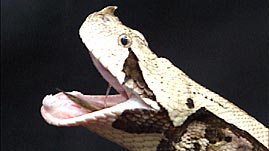Environmental conditions have shaped the evolution of every organism on the planet. From the spines on a cactus to the stripes of a tiger, countless physical and behavioral traits have grown out of the interaction between organisms and their environment. These traits, called adaptations, are the result of natural selection, and they give an organism the ability to survive and reproduce in its natural environment.
One environmental condition that has been particularly influential in the evolutionary process is food. Over millions of years, the amount and type of food available to various species has dramatically influenced both the manner in which animals find food and the physical traits they use to catch and eat their food. There are few better examples of evolutionary change in response to the pressure of finding food than that of the snake.
Snakes have existed for more than 65 million years, at least since the last days of the dinosaurs. Fossil evidence suggests that snakes evolved from a group of lizards that resembled present-day monitor lizards: The skull and backbone structure of these ancient lizards is similar to that of the earliest snakes. In addition, like some monitor lizards, the ancient lizards were probably quite good at burrowing underground, which may help to explain the evolution of snakes.
According to a leading theory on snake evolution, about 100 million years ago, some lizards began increasingly to pursue their prey underground. With dinosaurs occupying many of the niches above ground, small, burrowing mammals would have represented a largely untapped food resource for those animals that could reach them. While pursuing creatures underground may have favored lizards with large, powerful forelimbs, lizards with very slender bodies and short legs may also have had an advantage. Over million of years, if limbs were enough of a disadvantage to some of these lizards, the structures would have become obsolete.
The evolutionary loss of legs would certainly have presented legless lizards with a new set of challenges. However, these physical changes did not happen overnight. At the same time lizards were evolving shorter and shorter legs, they also would have been evolving a new form of locomotion. Their teeth and jaws, too, would have changed to serve an increasingly important role in the capture and handling of prey. While some types of snakes evolved one solution to subduing their prey, with large teeth and jaws and bodies powerful enough to suffocate an animal, other types of snakes evolved venom and modified teeth that would carry the venom into their victims' bodies. Over time, too, evolution led to the ability snakes have to unhinge their jaws. This has the undoubted advantage of allowing snakes to eat very large animals without first biting or tearing them into smaller pieces.

 Loading Standards
Loading Standards Teachers' Domain is proud to be a Pathways portal to the National Science Digital Library.
Teachers' Domain is proud to be a Pathways portal to the National Science Digital Library.
